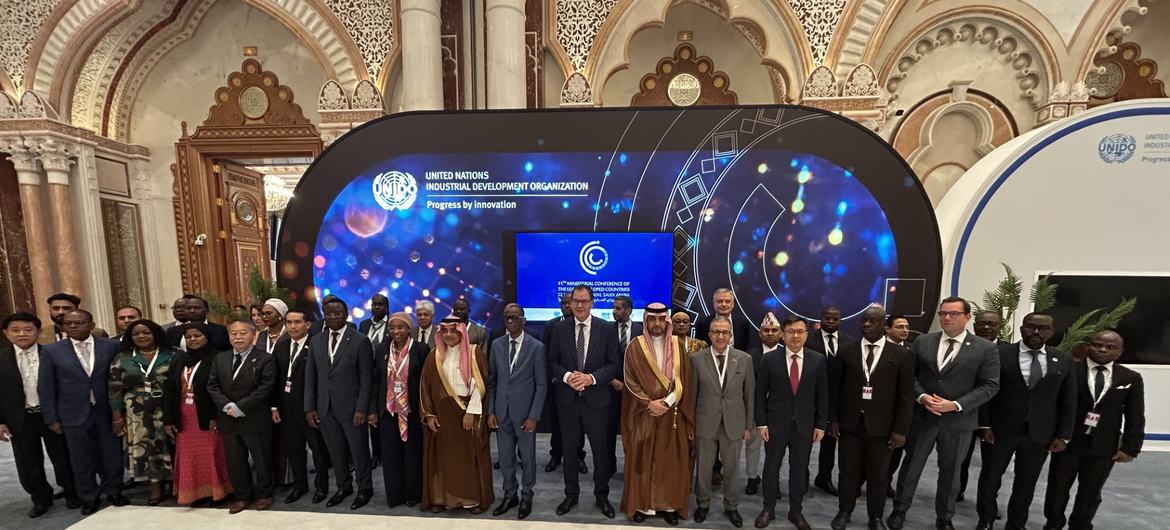‘Leave no one behind’: As wealth gap widens, UN calls for new industrial deal for world’s poorest – UN News

Report on the Eleventh Ministerial Conference of Least Developed Countries: Industrialization for Sustainable Development
Introduction
A ministerial conference for the world’s Least Developed Countries (LDCs), convened by the United Nations Industrial Development Organization (UNIDO), was held in Riyadh to address economic development challenges. Representatives from LDCs across Asia, Africa, and the Caribbean gathered to discuss strategies for building economic resilience. A key focus was the critical role of industrialization in post-conflict recovery, as exemplified by the situation in Sudan, where restarting factories is seen as a vital step following the cessation of hostilities. The proceedings underscored that sustainable industrial development is fundamental to achieving the 2030 Agenda for Sustainable Development.
The Role of Industrialization in Achieving the SDGs
UNIDO Director-General Gerd Müller stated that industrialization is essential for achieving the Sustainable Development Goals (SDGs). He highlighted the widening gap between the world’s wealthiest and poorest populations as a major obstacle to global progress, directly impacting SDG 10 (Reduced Inequalities). LDCs are particularly vulnerable to economic shocks, including climate change and trade tariffs, which threaten livelihoods in key sectors like textiles, agribusiness, and manufacturing. Mr. Müller called for enhanced global solidarity and multilateralism, reinforcing SDG 17 (Partnerships for the Goals), to ensure LDCs can build resilient economies and make meaningful progress on the SDGs.
UNIDO Initiatives and SDG Alignment
UNIDO’s mission is to support countries in their industrialization efforts to foster resilience and improve quality of life. The organization’s projects are directly aligned with achieving specific SDGs:
- SDG 9 (Industry, Innovation, and Infrastructure): UNIDO’s core mandate is to promote inclusive and sustainable industrialization. This is demonstrated through initiatives like supporting agribusiness in Sudan and promoting digital skills for youth in Nepal.
- SDG 8 (Decent Work and Economic Growth): In Bangladesh, UNIDO training programs have helped garment factories meet international standards, leading to the creation of millions of jobs, particularly for women.
- SDG 5 (Gender Equality): Programs in both Bangladesh and Sudan specifically target the economic empowerment of women by providing access to jobs, finance, and entrepreneurial opportunities.
- SDG 16 (Peace, Justice, and Strong Institutions): By supporting the private sector in conflict-affected nations like Sudan, UNIDO helps lay the groundwork for economic stability, which is a crucial component of sustainable peace.
Conference Outcomes and Commitments to the 2030 Agenda
The Eleventh Ministerial Conference resulted in several key outcomes aimed at accelerating industrial development in LDCs in line with the global goals. These commitments represent a decisive step toward ensuring vulnerable nations can participate and thrive in the global economy.
- Ministerial Declaration Adopted: Ministers reaffirmed their commitment to inclusive and sustainable industrialization as a primary driver for achieving the SDGs.
- UNIDO Operational Strategy Endorsed: A roadmap for scaling up UNIDO support to LDCs through 2031 was approved, focusing on technology transfer and knowledge sharing to advance SDG 9.
- Partnerships Strengthened: New commitments were made for financing, capacity-building, and technology transfer, strengthening the framework of SDG 17.
- Policy Frameworks Agreed: The conference highlighted youth empowerment, gender equality (SDG 5), and climate adaptation (SDG 13) as priority areas to be integrated into national industrial policies.
Analysis of SDGs in the Article
1. Which SDGs are addressed or connected to the issues highlighted in the article?
-
SDG 1: No Poverty
The article focuses on the economic challenges of the “world’s poorest countries,” specifically the Least Developed Countries (LDCs). It highlights the widening gap between the rich and poor, noting that “the poorest half of the world’s population increased theirs [wealth] by only one per cent” between 2000 and 2024, directly addressing the core issue of poverty.
-
SDG 5: Gender Equality
The article explicitly mentions gender equality as a priority in the conference outcomes. It provides concrete examples of UNIDO’s work promoting this goal, such as training programs in Bangladesh that have “creat[ed] millions of jobs for women” and initiatives in Sudan that help “women to access finance.”
-
SDG 8: Decent Work and Economic Growth
The central theme is economic development and recovery. The article discusses the need to “restart the factories” in Sudan, create jobs, and support vital sectors like “textile, leather, agribusiness and equipment.” UNIDO’s mission to help countries improve lives through industrialization directly supports sustainable economic growth and productive employment.
-
SDG 9: Industry, Innovation, and Infrastructure
This is the most prominent SDG in the article. The entire piece revolves around the work of the United Nations Industrial Development Organization (UNIDO) and its mission to promote “inclusive industrialisation.” The conference outcomes include commitments to “modernising industry,” “transferring technology and knowhow,” and scaling up support for industrial development in LDCs.
-
SDG 10: Reduced Inequalities
The article directly addresses inequality by citing a statistic from 500 Nobel Laureates: “between 2000 and 2024, the richest one per cent of the world’s population increased their wealth by 41 per cent, whilst the poorest half of the world’s population increased theirs by only one per cent.” UNIDO’s Director-General calls for action “to keeping the gap between rich and poor from growing even wider.”
-
SDG 16: Peace, Justice, and Strong Institutions
The article opens by establishing the link between conflict and development, with the advisor to Sudan’s Minister of Industry and Trade stating, “First, we need to end the war. Then, we have to restart the factories.” This highlights that peace and stability are prerequisites for economic development and industrialization.
-
SDG 17: Partnerships for the Goals
The article emphasizes the importance of global cooperation. The Director-General of UNIDO calls for “global solidarity” and “multilateralism.” The conference itself is a partnership, and its outcomes include “Partnerships strengthened” with “new commitments for financing, capacitybuilding and technology transfer,” which are key components of SDG 17.
2. What specific targets under those SDGs can be identified based on the article’s content?
-
Target 8.2: Achieve higher levels of economic productivity through diversification, technological upgrading and innovation.
The commitment to “modernising industry” and the focus on “transferring technology and knowhow” directly align with this target. The support for diverse sectors like “textile, leather, agribusiness and equipment” also points to economic diversification.
-
Target 9.2: Promote inclusive and sustainable industrialization and, by 2030, significantly raise industry’s share of employment and gross domestic product… and double its share in least developed countries.
The article’s entire focus on UNIDO’s mission to support LDCs in industrializing is a direct reflection of this target. The Ministerial Declaration reaffirming a “commitment to inclusive industrialisation” is a clear indicator of this goal.
-
Target 9.b: Support domestic technology development, research and innovation in developing countries.
The agreement on “guidelines for scaling up UNIDO support – focusing on transferring technology and knowhow” is a practical step towards achieving this target by building local capacity.
-
Target 5.b: Enhance the use of enabling technology… to promote the empowerment of women.
While not the primary focus, the mention of equipping young people in Nepal with “coding and digital skills” and helping women in Sudan “access finance” implies the use of technology to empower marginalized groups, including women.
-
Target 16.1: Significantly reduce all forms of violence and related death rates everywhere.
The statement, “First, we need to end the war,” directly addresses the need to reduce violence and conflict as a precondition for development, which is the essence of this target.
-
Target 17.9: Enhance international support for implementing effective and targeted capacity-building in developing countries.
The conference outcome of strengthening partnerships for “capacitybuilding and technology transfer” and UNIDO’s training programs in Bangladesh are direct examples of actions that fulfill this target.
3. Are there any indicators mentioned or implied in the article that can be used to measure progress towards the identified targets?
-
Indicator for SDG 8 & 9 (e.g., 8.5.2, 9.2.2): Number of jobs created.
The article explicitly states that in Bangladesh, UNIDO’s programs have helped in “creating millions of jobs for women.” This is a direct quantitative indicator of progress in employment.
-
Indicator for SDG 10 (e.g., 10.1.1): Growth rates of household expenditure or income per capita among the bottom 40 percent of the population and the total population.
The article provides a stark, albeit informal, indicator of inequality by citing the statistic that “the richest one per cent of the world’s population increased their wealth by 41 per cent, whilst the poorest half of the world’s population increased theirs by only one per cent.” This data directly measures the disparity in wealth growth.
-
Indicator for SDG 5 (e.g., 5.a.1): Proportion of women with ownership or secure rights over agricultural land; and share of women among owners or rights-bearers of agricultural land.
While not a direct match, the initiative in Sudan to help “women to access finance” implies an effort to increase women’s economic resources and control, which is a measurable outcome related to economic empowerment indicators.
-
Indicator for SDG 17 (e.g., 17.2.1): Net official development assistance (ODA).
The article implies this indicator by mentioning the vulnerability of LDCs to “major cuts to overseas aid and development support from the wealthiest nations.” The level of this support is a key metric for measuring global partnership and solidarity.
4. Table of SDGs, Targets, and Indicators
| SDGs | Targets | Indicators |
|---|---|---|
| SDG 9: Industry, Innovation, and Infrastructure | 9.2: Promote inclusive and sustainable industrialization and significantly raise industry’s share of employment and GDP in LDCs. | Implied: Share of industry in the economy (from the goal to “restart the factories” and “modernise industry”). |
| SDG 8: Decent Work and Economic Growth | 8.2: Achieve higher levels of economic productivity through diversification and technological upgrading. | Mentioned: Number of jobs created (“millions of jobs for women” in Bangladesh). |
| SDG 5: Gender Equality | 5.b: Enhance the use of enabling technology to promote the empowerment of women. | Implied: Number/proportion of women accessing finance (from the initiative in Sudan). |
| SDG 10: Reduced Inequalities | 10.1: Sustain income growth of the bottom 40 per cent of the population at a rate higher than the national average. | Mentioned: Wealth growth disparity (Richest 1% gained 41% vs. poorest half gained 1%). |
| SDG 16: Peace, Justice, and Strong Institutions | 16.1: Significantly reduce all forms of violence. | Implied: Presence/absence of conflict (from the statement “First, we need to end the war”). |
| SDG 17: Partnerships for the Goals | 17.9: Enhance international support for capacity-building in developing countries. | Implied: Amount of development support/aid (from the mention of “cuts to overseas aid and development support”). |
Source: news.un.org
What is Your Reaction?
 Like
0
Like
0
 Dislike
0
Dislike
0
 Love
0
Love
0
 Funny
0
Funny
0
 Angry
0
Angry
0
 Sad
0
Sad
0
 Wow
0
Wow
0




















































.jpg.webp?itok=0ZsAnae9#)




























